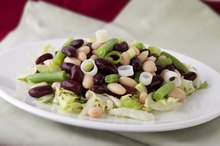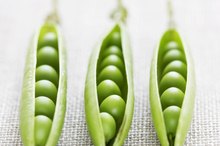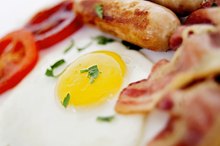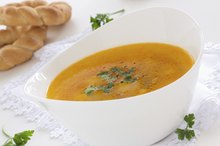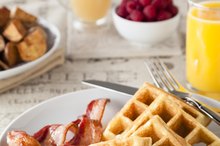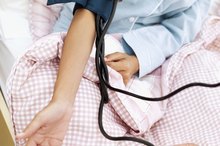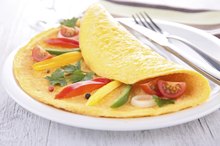What does fact checked mean?
At Healthfully, we strive to deliver objective content that is accurate and up-to-date. Our team periodically reviews articles in order to ensure content quality. The sources cited below consist of evidence from peer-reviewed journals, prominent medical organizations, academic associations, and government data.
The information contained on this site is for informational purposes only, and should not be used as a substitute for the advice of a professional health care provider. Please check with the appropriate physician regarding health questions and concerns. Although we strive to deliver accurate and up-to-date information, no guarantee to that effect is made.
South Beach Phase 1 Food List
Dr. Arthur Agatston, a cardiologist, designed the South Beach Diet to help people lose weight and reduce the risk of cardiovascular disease and other chronic diseases 123. Each of the plan’s three phases includes three meals, two snacks and a dessert each day. Phase 1 excludes certain foods to help you beat sugar cravings, so you need to know which foods you can eat during this 14-day phase.
Lean Proteins
Include a small portion of a lean source of protein at breakfast, lunch and dinner during phase 1. Avoid fatty choices, such as brisket and chicken wings, and choose low-sodium, nitrate-free prepared meats.
Vegetables
A South Beach Diet Supercharged Food List
Learn More
Eat vegetables for lunch, dinner and breakfast whenever you can fit them into your meal during phase 1. You can have any kind of non-starchy vegetable, such as:
- greens
- eggplant
- onions
- summer squash
- mushrooms
- water chestnuts
- artichoke hearts
- cauliflower
- broccoli
Vegetables are low-calorie and filling. Use them for salads or add them to sandwiches or soups to make your meals more satisfying. During this phase, avoid starchy vegetables such as yams, potatoes, corn and peas. Fruit is also forbidden during this phase.
- Eat vegetables for lunch, dinner and breakfast whenever you can fit them into your meal during phase 1.
Nuts, Seeds and Peanuts
Nuts, peanuts and seeds provide healthy unsaturated fats and are low in saturated fats. This combination can help lower your blood cholesterol levels and decrease your risk for heart disease. The food list for phase 1 includes such options as sunflower seeds, almonds, peanuts, cashews and pistachios. You can also have flaxseed and walnuts, which provide alpha-linolenic acid, an essential fatty acid that may lower your risk for heart disease. Choose unsalted nuts and seeds to limit your sodium intake and promote lower blood pressure.
- Nuts, peanuts and seeds provide healthy unsaturated fats and are low in saturated fats.
- You can also have flaxseed and walnuts, which provide alpha-linolenic acid, an essential fatty acid that may lower your risk for heart disease.
Nutritious Dairy Products and Eggs
What Can You Eat on a Low-Oxalate, Low-Sodium, Low-Protein Diet?
Learn More
Cheese, fat-free yogurt, buttermilk and soy milk are allowed during phase 1. They provide calcium and protein. Eggs, which are also allowed, are high in protein and low in carbohydrates. You can have them scrambled, poached or in omelets for breakfast. Or, you can prepare hard-boiled eggs and egg whites ahead of time for snacks or to add to sandwiches and salads. Avoid full-fat cheese because of its high amount of saturated fat. Also forbidden are ice cream, frozen yogurt and sugar-sweetened yogurts because of they have high amounts of fat and added sugars.
- Cheese, fat-free yogurt, buttermilk and soy milk are allowed during phase 1.
- Or, you can prepare hard-boiled eggs and egg whites ahead of time for snacks or to add to sandwiches and salads.
Legumes
Beans, lentils and split peas are allowed. They provide protein and dietary fiber. While they are higher in carbohydrates than some other foods allowed during phase 1, they do not contain the added sugars that this phase limits. Lima, navy, garbanzo, kidney and black beans are examples of nutrient-rich beans. Vegetarian chili, black bean and vegetable soup, lentil soup and split pea soup are hearty options. Choose low-sodium canned beans and lentils or use dried ones to limit your sodium intake.
- Beans, lentils and split peas are allowed.
- Vegetarian chili, black bean and vegetable soup, lentil soup and split pea soup are hearty options.
Beverages, Condiments and Healthy Fats
The South Beach Diet emphasizes foods that are high in unsaturated fats, such as avocados and olive oil 123. Also stick to low-calorie beverages, such as coffee and tea, vegetable juice and unflavored seltzer water. You cannot have sugary sweets, but some treats to include might be sugar-free ice pops and gelatin, baking cocoa and sugar-free jam. Spices can help flavor your food without adding sodium, so stock up on a variety of spices such as:
- chili powder
- thyme
- turmeric
- basil
- oregano
- cinnamon
- nutmeg
- ginger
- The South Beach Diet emphasizes foods that are high in unsaturated fats, such as avocados and olive oil 1.
Related Articles
References
- South Beach Diet: Phase 1
- South Beach Diet: What Foods Can I Eat on the South Beach Diet?
- South Beach Diet: What is the South Beach Diet?
- Linus Pauling Institute: Essential Fatty Acids
- Foster, G.; Wyatt, H.; Hill, J. et al. Weight and metabolic outcomes after 2 years on a low-carbohydrate versus low-fat diet: a randomized trial. Ann Intern Med. 2010;153(3):147-57. DOI: 10.7326/0003-4819-153-3-201008030-00005.
- SBD Enterprises LLD. (2016) South Beach Diet: The Handbook. Washington, Pennsylvania: SBD Enterprises LLC.
Writer Bio
Natalie Stein specializes in weight loss and sports nutrition. She is based in Los Angeles and is an assistant professor with the Program for Public Health at Michigan State University. Stein holds a master of science degree in nutrition and a master of public health degree from Michigan State University.
